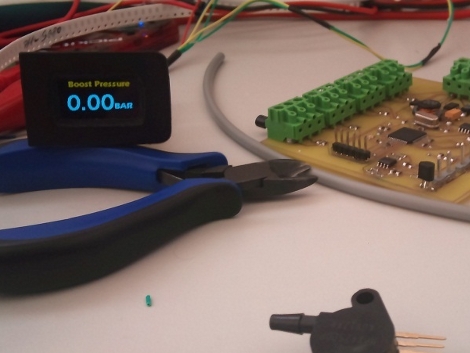
Here’s an interesting take on augmenting a car’s dashboard. [Daniel] is using a button blank to house a 1″ OLED display in his Jetta. It shows auxiliary data such as boost pressure and several sets of temperature readings. The display itself has a tiny little circuit board with a PIC 24 to drive it. A larger board, seen above, collects the temperature data from some sensors that [Daniel] added as part of the hack. There are some pictures of the installed display inside of the dark car and it looks really easy to read. It also sounds like there’s some dimming functionality built into the firmware. This is the easiest way we’ve seen to add a display to your dashboard as it just requires you to pop out a button blank, rather than disassembling the entire console or patching into what’s already there.















these displays are pretty cool. I remember them from the MPman MP3 players. looks like a job well done!
No info just photos, no sources for the displays..
kind of novel, I have seen this on other car forums for small LCD’s but if you link to something make sure it’s got details otherwise its fake.
VW 4 Life!
http://www.youtube.com/watch?v=qgEvy60bZYI
Sorry for useless comment, I just love my VW a whole bunch.
Maybe one of those:
http://www.crystalfontz.com/product/CFAL12864N-A-B1.html
Cool project, but it seems like a wiring nightmare. He is running sensors from the head unit to all of his sensing location. Wouldn’t it just be easier to tap into the OBDII or CAN bus?
what’s strange is, i was fixing a transmission flush machine this weekend that used that sensor you see there in the image posted to read the tank levels via air pressure. I thought it would be cool to hook one of those up to a micro controller and LCD and make a boost/vacuum gage out of it. wacky lol.
@queso:
He appears to have built a second board for the sensors that’s in the engine compartment. Probably communicates by some serial bus. At least he’s not pulled sensor lines all the way to the dash…
Hi Guys, sorry for the stupidly low amount of info given in those posts, but alas it is a motoring forum, not an electronics one.
The project was also an impromptu one, so documentation is scarce, as with most of my projects :)
All the sensor wires run to the secondary board in the engine bay, where a PIC24 samples them. The temp sensors are LM35’s mounted into original VW sensor housings. I measure the intake air, pre- and post-intercooler as well as EGT temperatures. The boost sensor is a MPX4250, good for 2.5bar of boost. The samples are then formatted into ‘C and bar values, packed and sent via a RS485 link to the display unit. Thus there are only 4 wires in a single core to run into the (very cluttered) dash. The display unit recieves them and display’s them on the OLED ( http://za.rs-online.com/web/search/searchBrowseAction.html?method=getProduct&R=0554134 ). Ask if you guys have questions, I’ll answer as I can.
Regards,
JVRDesign
this is cool.
been thinking about putting an embedded micro in my car — I would like to be able to read some data in my car’s computer via the diagnosis port (?) but I am not sure where to start. Maybe add some other stuff in there too – proximity sensing and a way to track gas economy if possible.
does anyone have any links to similar projects online or a good source for projects like this?
Someone e-mail me …..NISSAN wiring display work wanted.
okay one question please, what sensor are you using to measure 825c the exhaust temperature?
Looks nice! GF.A!
@ spiralbrain
Its a type K thermocouple, with a gain stage, accuraccy is about 30’C
I’ve been working off and on, on a similar project (which has at one point been on this site).
When I first put it up it was something that replaced the clock on a wrx console. Now it’s a small touchscreen.
http://www.robotmeter.com (has a link to the google code page too)
http://www.youtube.com/watch?v=oDBASpMAIUg
…and wtf is up with the youtube embedding. I kind of feel bad for posting it now….
@carhack
It wouldn’t be much of a hack, but I’ve been using a ScanGauge to read all of those things from the OBDII bus.
Building a table that can read your instant injector duty cycle, fuel pressure, and speed then extrapolate that in to mpg would be difficult to say the least.
@CapnBoost
That’s more or less what I did (on a vw as well). But while it makes for a cleaner install (with basically just connecting to the OBDII bus instead of running wires to all kinds of sensors) there’s advantages to this method as well… data rates from the OBDII are merely ‘acceptable’ while here he can probably sample as often as he wants (this is with my non-CAN Golf, perhaps the newer CAN network OBDII can do better than the 3-4 samples/second I’m getting out of the OBDII data).